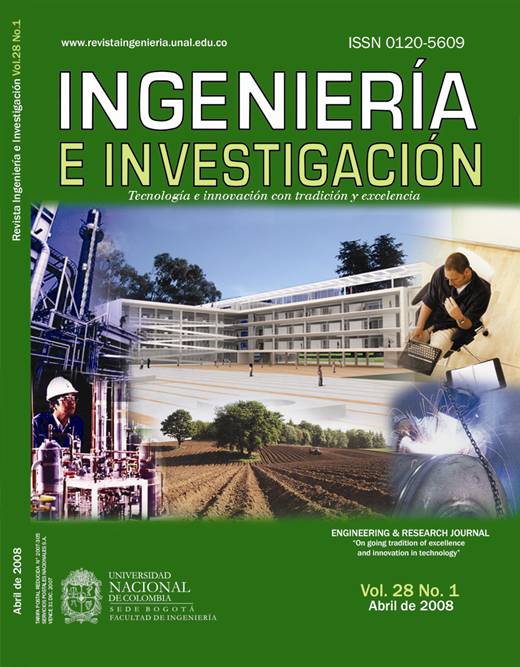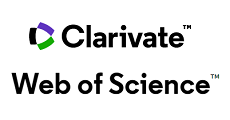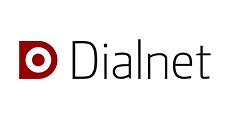Plataforma autónoma inteligente para fútbol robot
An intelligent autonomous platform for robot football
DOI:
https://doi.org/10.15446/ing.investig.v28n1.14870Keywords:
lógica difusa, planeación de trayectorias, fútbol robot, robot móvil, visión por computador (es)fuzzy logic, path planning, RoboSoccer, mobile robot, artificial vision, image processing (en)
Downloads
Este artículo presenta el diseño, la implementación y los resultados obtenidos, confrontados con simulación, de una plataforma hardware-software para fútbol robot en un entorno artificial que consta de un campo o arena de juego, un agente móvil controlado por la aplicación (AMC), un agente móvil controlado por usuario (MCU), una bola de golf, un sensor para capturar el estado del entorno y un controlador de trayectoria. El problema que enfrenta el agente AMC en su entorno es la búsqueda de una posición con línea de vista libre para golpear la bola hacia la portería del equipo contrario, mientras esquiva adversarios en su camino. El campo de juego es un área confinada de 1,5 m x 2 m, en la cual el agente móvil se desplaza según la cinemática de un robot diferencial a una velocidad máxima de 25,7cm/s, el móvil posee la capacidad de pateo de una bola de golf, la cual se puede impulsar a una velocidad máxima de 1,43 m/s. Por otro lado, se implementa y optimiza un sensor de posición. El proceso parte con la captura de imágenes de la arena de juego, continúa con la conversión al formato HSI y la aplicación de filtros digitales sobre las imágenes, y termina con el cálculo de las componentes cartesianas a partir de los patrones en color, que identifican a los móviles y bola de juego, la velocidad que alcanza el sensor es de 30 cuadros por segundo. Finalmente, se realiza el control de navegación inteligente a través de una estrategia híbrida, en la cual se combina linealmente el efecto de dos controladores basados en lógica difusa, uno para llevar el agente a la posición de tiro al arco y el otro para esquivar obstáculos mientras navega a la posición de tiro.
This article presents the design, implementation, virtual simulation and test results for a hardware-software platform for robot soccer. The platform consists of a soccer field, a software-controlled mobile agent (AMC), a user-controlled mobile agent (MCU), a golf ball, an image sensor system and a path-planning controller. The problem for agent AMC is to sense the environment and move to a kicking position to score while avoiding opponents in its way. The soccer field is a bounded area of 1.5m x 2m in which mobile agents move following differential robot kinematics at 25.7cm/s speed; each robot has a kicking system which can speed up a golf ball at 1.43m/s velocity. A position sensor was implemented and optimised in three stages: capturing the soccer field image, converting to HSI format and applying digital filters and calculating the Cartesian components from colour patterns for identifying the mobile robots and the golf ball. Image sensor system processing speed is 30 frames per second. Robot path planning is controlled by a hybrid strategy based on two linearly combined fuzzy logic controllers; one takes agent AMC to the goal position and the other avoids obstacles while it moves to the goal position.
References
Birk, A., Coradeschi, S., Tadokoro, S., RoboCup 2001: Robot Soccer World Cup V., Springer, 2001. DOI: https://doi.org/10.1007/3-540-45603-1
Browning, B., Bowling, M., Bruce, J., Balasubramanian, R., Veloso, M., CM-Dragons’01 – Vision-Based Motion Trackink and Heteregeneous Robots., RoboCup 2001: Robot Soccer World Cup V., Springer, 2001, pp. 667-570. DOI: https://doi.org/10.1007/3-540-45603-1_85
Burkhard, H., Duhant, D., Fujita, M., Lima, P., Murphy, R. y Rojas R., The Road to RoboCup 2050., IEEE Robotics and Automation Magazine., Junio 2002, pp. 31-38. DOI: https://doi.org/10.1109/MRA.2002.1019488
Costa, Pa., Sousa, A., Marques, P., Costa, Pe., Gaio, S., Moreira, A., 5dpo Team Description., RoboCup 2001: Robot Soccer World Cup V. Springer, 2001, pp. 653-566. DOI: https://doi.org/10.1007/3-540-45603-1_84
De la Rosa, J., Innocenti, B., Montaner, M., Figueras, A., Muñoz, I., Ramon, J. A., Rogi Team Description, RoboCup 2001: Robot Soccer World Cup V. Springer, 2001, pp. 687-590. DOI: https://doi.org/10.1007/3-540-45603-1_90
Driankov, D., Hellendoorm, H., Reinfrank, M., An introduction to fuzzy control., Springer-Verlag, 1996. DOI: https://doi.org/10.1007/978-3-662-03284-8
Hibino, S. Kodama, Y., Nagasaka, Y., Takahashi, T., Murakami, K., Naruse, T., Owarabito – A Team Description., RoboCup 2001: Robot Soccer World Cup V. Springer, 2001, pp. 679-582. DOI: https://doi.org/10.1007/3-540-45603-1_88
Kitano, H., Tambe, M., Stone, P., Veloso, M., Coradeschi, S., Osawa, E., Matsubara, H., Noda, I., Asada. M., The RoboCup Synthetic Agent Challenge 97., Proc. 15., Joint conf. on Artificial Intelligence., San Francisco C
A, 1997, pp.24-29.
Kortenkamp, D., Huber, M., Cohen, C., Raschke, U., Bidlack, C., Congdon, C., Koss, F., Weymouth, T., Winning the AAAI Robot Competition., Proc. AAAI’93, National Conference on Artificial Intelligence. San Jose, California, pp. 858-859.
Molina, F., Cardenas, J., Tesis: Control de un equipo de fútbol Robótico Según Especificaciones de la Categoría Small Size Robocup., Universidad Nacional de Colombia, Ingeniería Electrónica, Bogotá, 2005.
Rojas, R., Behnke, S., Liers, A., Knipping, L., FU-Fighters 2001 (Global vision)., RoboCup 2001: Robot Soccer World Cup V. Springer, 2001, pp. 671-574. DOI: https://doi.org/10.1007/3-540-45603-1_86
Soriano, J., Gonzalez, O., Munar, F., Ramos, A., Propuesta de ‘defuzzifier’ basado en relaciones booleanas., Revista Ingeniería, Universidad Distrital Francisco José de Caldas, Vol 6, No 2, 2001.
Sotomonte, W., Tesis: Comparación de estrategias Multi Agente, caso de estudio: Fútbol Robot.,
Universidad Nacional de Colombia, Maestría en automatización Industrial, Bogotá, 2006.
Wakerly, J.F., Digital Design, Principles and practices., Third Edition, Prentice Hall., 1999.
Wyeth, G., Brown, B., Robust Adaptive Vision for Robot Soccer., Computer Science and Electrical Engineering., University of Queensland. Australia, 2000.
Young, G. O., Synthetic structure of industrial plastics., 2nd ed. vol. 3, Ed. New York: McGraw-Hill, 1964, pp. 15- 64.
Robocup., Definición de Robocup. Disponible: http://www.robocup.org
How to Cite
APA
ACM
ACS
ABNT
Chicago
Harvard
IEEE
MLA
Turabian
Vancouver
Download Citation
License
Copyright (c) 2008 Cesar Hernán Rodríguez Garavito, Jesús Alberto Delgado Rivera

This work is licensed under a Creative Commons Attribution 4.0 International License.
The authors or holders of the copyright for each article hereby confer exclusive, limited and free authorization on the Universidad Nacional de Colombia's journal Ingeniería e Investigación concerning the aforementioned article which, once it has been evaluated and approved, will be submitted for publication, in line with the following items:
1. The version which has been corrected according to the evaluators' suggestions will be remitted and it will be made clear whether the aforementioned article is an unedited document regarding which the rights to be authorized are held and total responsibility will be assumed by the authors for the content of the work being submitted to Ingeniería e Investigación, the Universidad Nacional de Colombia and third-parties;
2. The authorization conferred on the journal will come into force from the date on which it is included in the respective volume and issue of Ingeniería e Investigación in the Open Journal Systems and on the journal's main page (https://revistas.unal.edu.co/index.php/ingeinv), as well as in different databases and indices in which the publication is indexed;
3. The authors authorize the Universidad Nacional de Colombia's journal Ingeniería e Investigación to publish the document in whatever required format (printed, digital, electronic or whatsoever known or yet to be discovered form) and authorize Ingeniería e Investigación to include the work in any indices and/or search engines deemed necessary for promoting its diffusion;
4. The authors accept that such authorization is given free of charge and they, therefore, waive any right to receive remuneration from the publication, distribution, public communication and any use whatsoever referred to in the terms of this authorization.



























